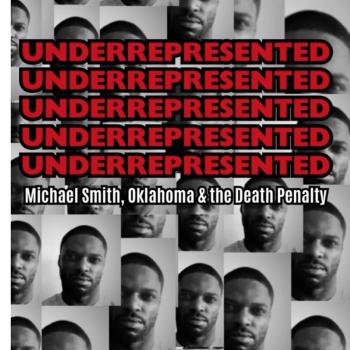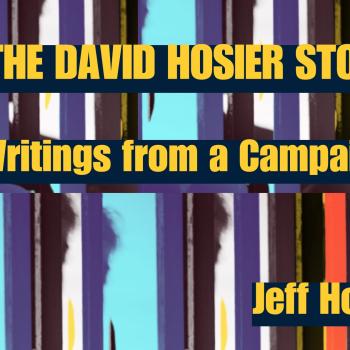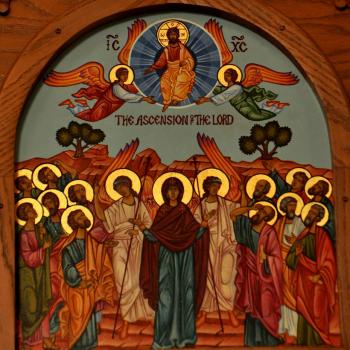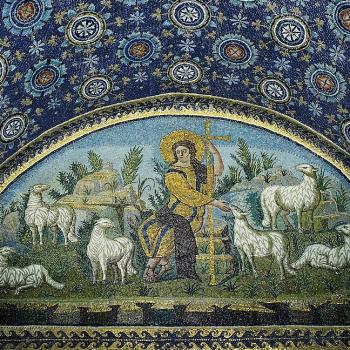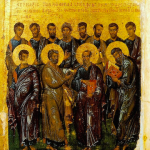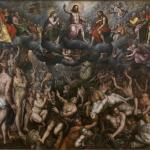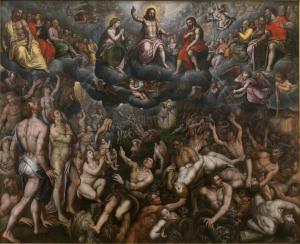
Christian Scripture offers us a glimpse of what is to be in the eschaton, sometimes in ways which appear to be contradictory, which is why there are various, often contradictory, interpretations and beliefs concerning it. Some Christians believe that Scripture indicates that those who are not “saved” will be annihilated (a view, to be sure, repudiated by most Christian traditions). Most Christians believe that everyone will be brought back to life in a general resurrection from the dead, whereupon everyone will be told exactly what their eternal status will be (that is, whether they will be called to join Christ in the kingdom of God or they will be sent away from him and thrown into the lake of fire). Some Christians think Scripture is not clear about the eschaton because we are not meant to know until the eschaton itself, using this to suggest we can hope all will be saved. Others believe all will be saved, and the warnings concerning an eternal hell are pedagogical in nature. Thus, most Christians do not believe in annihilationism, however, some do, and those who do think Scripture suggests it; why do they think this?
Perhaps Revelation 10:11-15 can be read as the most supportive of the notion of annihilationism; that passage says that those who are not found in the “book of life,” that is, not “saved” will be sent to the lake of fire and be taken in by the “second death”:
Then I saw a great white throne and him who sat upon it; from his presence earth and sky fled away, and no place was found for them. And I saw the dead, great and small, standing before the throne, and books were opened. Also another book was opened, which is the book of life. And the dead were judged by what was written in the books, by what they had done. And the sea gave up the dead in it, Death and Hades gave up the dead in them, and all were judged by what they had done. Then Death and Hades were thrown into the lake of fire. This is the second death, the lake of fire; and if any one’s name was not found written in the book of life, he was thrown into the lake of fire (Rev. 10:11-15 RSV).
As our temporal death, the end of our temporal life, is the first death, annihilationists suggest that the second death must be seen as the final end of our existence. Those sent to the lake of fire to experience the second death perish, never to come back to life. Sin, which seeks to destroy and corrupt being until it is completely annihilated, would be victorious, for what is sent into the lake of fire, sinners who remain attached to their sins, will be eliminated from existence itself. While this interpretation of the second death and the lake of fire is wrong, because it would prove sin and death, not Christ, to be victorious, there is an element of it which is correct. The lake of fire does serve as a kind of ending, to which, something which is brought to it finds its connection to reality, to being itself, destroyed, leading to its elimination. But what is destroyed, what is brought to an end, is not the person, or anything which can be said to have a share in existence, but rather, sin itself, thus bringing an end to the power and influence of sin. What sin had corrupted finds itself freed from sin, that is, it will find itself made pure as it is brought to the purifying flame of the lake of fire. Then, instead of seeing the eschatological outcome being a victory of sin and death over God, God (in and through Christ) is the one who is victorious as sin and death no longer reigns over creation. Then God, the source and foundation of every being, of existence itself, can be and will be shared by all; that is, God will be all in all:
The last enemy to be destroyed is death. “For God has put all things in subjection under his feet.” But when it says, “All things are put in subjection under him,” it is plain that he is excepted who put all things under him. When all things are subjected to him, then the Son himself will also be subjected to him who put all things under him, that God may be everything to every one (1 Cor. 15:26-28 RSV).
Death is destroyed at the second death, so that the second death can be said to be the death of death itself. The power of death, the power of sin, the power of hell itself, is put to and end by Christ: “To destroy a hostile power means to do away with the right of this power so that it no longer remains, and the annihilation of the power means to abolish the government of the kingdom.”[1] The kingdom of death is abolished: Christ conquers death by death itself, that is, by bringing death to death. Life, being, and existence, is confirmed and strengthened and reinforced by Christ. All those who had died will experience the end of death itself, and in that experience, find themselves coming back to life.
Thus, what we see established in the eschaton is the elimination of all that has corrupted and destroyed being, so that being itself is freed and all the good contained in being, all the good which sin and death tried to destroy, is preserved for eternity. Due to the way sin connects to us, in and through our actions, we confuse what we become through its influence with our true self; that is, we end up covering up our true nature, our true goodness, our inherent persona, with the mask of sin, and then confuse what that mask presents as being our true persona and so act in relation to our false persona, reinforcing that false persona so long as we do so. But once sin and death is cast in the lake of fire, that mask, that false persona, likewise is cast away, freeing us from that persona and the corruption it imposed upon us. In this fashion, the wicked which are destroyed in the lake of fire is all those masks, and the false personas they generated, so that persons which were covered up find themselves revealed and set free:
‘But the way of the wicked vanishes.’ That does not mean that the wicked will perish. If they repent and do penance, they too will be saved. When the Apostle Paul was persecuting Christ and His Church, he was wicked. If the wicked perish, there is no chance for their repentance. It does not say that the wicked shall perish, but the way of the wicked vanishes, that is, wickedness shall perish. Not the wicked, but wickedness itself; not the one who was wicked will perish, but while he is repenting, wickedness vanishes. [2]
St. Gregory of Nyssa, reflecting upon 1 Cor. 15, and the way Christ is said to subjugate himself to the Father (which he says is in and through his body, the church, that is, in and through us), points out that the purpose of that passage is to indicate the way God will free and restore all the good God gave creation as its inception so that nothing will end up being outside the kingdom of God:
What, then, is the heart of the doctrine that the divine Apostle is teaching us in this passage? It is that at some point the nature of evil will be transformed into non-existence, completely made to disappear from reality, and pure divine goodness will contain all rational nature within itself; nothing of all that has come into being from God will fall outside the boundaries of God’s Kingdon, but when all the evil has been mingled with existing things has been consumed, like some material impurity, by the melting-process of purifying fire, everything will become just as it was when it had its origin from God—as it was when it had not yet come to share in evil.[3]
Thus, what is eliminated is that which is said to be evil, for evil has no place in the kingdom of God. What remains after that evil is removed is the good which God created. But, some might ask, does that not mean something is being annihilated, that is, is not some part of existence is being destroyed? Gregory, like many others, would point out evil itself has no real existence, it is not a thing, certainly not a thing created by God, and as such, we talk about its elimination from being only as a convention. Thus, when it is detached from the good which it holds to, it has nothing of its own, and this is revealed in the way it does not exist once it is cut off from the good of something else. When evil is mixed with some good, it seems to have a life and existence of its own, but it does not, it only borrows from the good which it corrupts. This is why in the eschaton, evil can be removed, without God destroying something which God has created:
But submission to God is the utter removal of evil. When, then, all of us come to be outside of the realm of evil, its imitation of our “first-fruit,” then the whole mix that is nature, blended in with the first-fruit and becoming one body in its solidarity, will receiving within itself the rule of the Good alone; so, with the whole body of our nature mingled with the divine, immortal nature, that subjection here ascribed to the Son will become reality through us, as subjection is brought to fulfillment in his Body and is referred to him, who works in us the grace of submission.[4]
Sergius Bulgakov is right when he said that in the eschatological judgment, evil is shown not have a nature or existence of its own; it was not established in us by God, but by our creaturely choice, as we, through choice, mixed the corrupting nature of sin with our good nature. Then, the good which was made impure by evil can once again be pure, leading, then, to the “apokatastasis” or return of all things back to their initial good (which is, to be sure, not the end which God wants for us, but rather, the foundation for that goal, for what God wants for us is theosis, our own participation in the divine nature, making us greater than what we were in our creation):
Therefore, if we can speak of apocatastasis, then this is only in the sense of ontological anamnesis – in the sense of the beginning, not of the end. In the world nothing is lost and nothing is annihilated except evil, conquered by the power of God and thereby exposed in its non-being. But the history of the world, which is also the history of the Church, is the building up of the kingdom of God, the City of God. And this can be called apocatastasis only in the sense of the universal salvation whose foundation was already laid when all that exists was created. [5]
Thus, there is a way we can talk about the annihilation of evil, but we must realize when we do so, it is a poetic convention which helps us understand what is going to happen. In the end, the insubstantial nature of evil will be revealed as it will be shown to have no true existence, and so there is, in a sense, nothing which is eliminated. Evil is the concept we use to describe our experience of the corruption of being, or of those acts which counter the good which should be done and the corruption of being those acts then generate, a corruption which seeks to spread itself throughout all being, corrupting and destroying all things. But, thanks to Christ, death has met with death, the corruption of being has met itself, and in doing so, eliminates itself, freeing all created things from the power which sought to destroy them. We will see and experience this in the eschatological judgment, and the false personas which evil has created will be “put to the fire” like effigies, leaving the good person which it had hidden behind, freeing them to finally embrace that which is good without any taint or compulsion from the false persona which they had previously embraced. The second death, the judgment which is to come, brings about the destruction or elimination of all such illusory personas; so long as someone struggles to hold onto that false persona, to keep themselves masked by it, they will experience the purifying fire of God’s love, but once they let it go, then they will find God will free them all the pain and suffering evil brings and at last, they will be able to experience the glory of God, the glory which God shares with all being, for themselves.
[1] St. Hilary of Poitiers, The Trinity. Trans. Stephen McKenna, CSSR (New York: Fathers of the Church, Inc., 1954), 486.
[2] St. Jerome, The Homilies of Saint Jerome: Volume I (1-59 On the Psalms). Trans. Marie Liguori Ewald, IHM (Washington, DC: CUA Press, 1963), 13 [Homily 1].
[3] St. Gregory of Nyssa, “On the ‘Final Subjection’ of Christ” in On Death and Eternal Life. Trans. Brian E. Daley (Yonkers, NY: St. Vladimir’s Seminary Press, 2022), 74.
[4] St. Gregory of Nyssa, “On the ‘Final Subjection’ of Christ,” 76.
[5] Sergius Bulgakov, “On the Question of the Apocatastasis of the Fallen Spirits ” in The Sophiology of Death. Essays on Eschatology: Personal, Political, Universal. Trans. Roberto J. De La Noval (Eugene, OR: Cascade Books, 2021), 90-91.
Stay in touch! Like A Little Bit of Nothing on Facebook.
If you liked what you read, please consider sharing it with your friends and family!
N.B.: While I read comments to moderate them, I rarely respond to them. If I don’t respond to your comment directly, don’t assume I am unthankful for it. I appreciate it. But I want readers to feel free to ask questions, and hopefully, dialogue with each other. I have shared what I wanted to say, though some responses will get a brief reply by me, or, if I find it interesting and something I can engage fully, as the foundation for another post. I have had many posts inspired or improved upon thanks to my readers.



